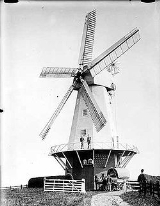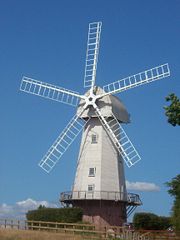
Ringle Crouch Green Mill, Sandhurst
Encyclopedia
Ringle Crouch Green Mill is a smock mill
in Sandhurst
, Kent
, England
that was demolished to base level in 1945, and now has a new smock tower built on it as residential accommodation and an electricity generator.
millwright to replace a post mill
which had stood at Boxhurst Farm that was blown down in 1842. It was the only corn mill built in Kent with five sails. The mill was built for James Collins, who ran the mill until his death. His son Edward then took the mill and ran it until his death in 1911. The mill was run for a short time by Edward Collins' sons Edward and Harry, then by C J Bannister, who also had a mill at Northiam
, for about a year until the mill ceased working in 1912.
A sail blew off, and the mill quickly became derelict. The fantail
and shutters were taken down, and in 1926 the stage was taken down. An iron windpump was erected alongside the mill, and three water tanks were installed in the mill to supply nearby cottages and cowsheds. The smock was demolished in 1945 The base was left standing and used as a Scout
hut for a time.
In 1997, planning permission was applied for, and granted, to build a replica mill on the existing mill base, with the tower being used as living accommodation and a wind turbine for generating electricity. The new building was to replicate the former windmill, with five sails like the original mill had.
 Ringle Crouch Green Mill was a four storey smock mill on a two storey brick base, with a Kentish style cap carrying five single patent sails
Ringle Crouch Green Mill was a four storey smock mill on a two storey brick base, with a Kentish style cap carrying five single patent sails
on a cast iron
windshaft. It was winded by a fantail
. There was a stage at second floor level. The mill drove four pairs of millstone
s.
The reconstructed mill has a four storey smock on the original two storey mill base, with the cap of a different design to the original, and lacking a fantail. The sails are 12.5 metres (41 ft) long each. The generator is rated at about 20 kW capacity.
References for above:-
Smock mill
The smock mill is a type of windmill that consists of a sloping, horizontally weatherboarded tower, usually with six or eight sides. It is topped with a roof or cap that rotates to bring the sails into the wind...
in Sandhurst
Sandhurst, Kent
The village of Sandhurst is in Kent near the border with East Sussex. It is situated very close to Bodiam. It is located on the A268 near the villages of Hawkhurst and Northiam...
, Kent
Kent
Kent is a county in southeast England, and is one of the home counties. It borders East Sussex, Surrey and Greater London and has a defined boundary with Essex in the middle of the Thames Estuary. The ceremonial county boundaries of Kent include the shire county of Kent and the unitary borough of...
, England
England
England is a country that is part of the United Kingdom. It shares land borders with Scotland to the north and Wales to the west; the Irish Sea is to the north west, the Celtic Sea to the south west, with the North Sea to the east and the English Channel to the south separating it from continental...
that was demolished to base level in 1945, and now has a new smock tower built on it as residential accommodation and an electricity generator.
History
Ringle Crouch Green Mill was built in 1844 by William Warren, the HawkhurstHawkhurst
Hawkhurst is a village and civil parish in the borough of Tunbridge Wells, Kent, England. The parish lies to the south-east of Tunbridge Wells. Hawkhurst itself is virtually two villages...
millwright to replace a post mill
Post mill
The post mill is the earliest type of European windmill. The defining feature is that the whole body of the mill that houses the machinery is mounted on a single vertical post, around which it can be turned to bring the sails into the wind. The earliest post mills in England are thought to have...
which had stood at Boxhurst Farm that was blown down in 1842. It was the only corn mill built in Kent with five sails. The mill was built for James Collins, who ran the mill until his death. His son Edward then took the mill and ran it until his death in 1911. The mill was run for a short time by Edward Collins' sons Edward and Harry, then by C J Bannister, who also had a mill at Northiam
Northiam
Northiam is a village and civil parish in the Rother District of East Sussex, England. The village is located thirteen miles north of Hastings in the valley of the River Rother. The main road that passes through it is the A28 which goes to Canterbury and Hastings.-Governance:The lowest level of...
, for about a year until the mill ceased working in 1912.
A sail blew off, and the mill quickly became derelict. The fantail
Windmill fantail
A Fantail is a small windmill mounted at right angles to the sails, at the rear of the windmill, and which turns the cap automatically to bring it into the wind. The fantail was patented in 1745 by Edmund Lee, a blacksmith working at Brockmill Forge near Wigan, England, and perfected on mills...
and shutters were taken down, and in 1926 the stage was taken down. An iron windpump was erected alongside the mill, and three water tanks were installed in the mill to supply nearby cottages and cowsheds. The smock was demolished in 1945 The base was left standing and used as a Scout
Scouting
Scouting, also known as the Scout Movement, is a worldwide youth movement with the stated aim of supporting young people in their physical, mental and spiritual development, that they may play constructive roles in society....
hut for a time.
In 1997, planning permission was applied for, and granted, to build a replica mill on the existing mill base, with the tower being used as living accommodation and a wind turbine for generating electricity. The new building was to replicate the former windmill, with five sails like the original mill had.
Description

Windmill sail
Windmills are powered by their sails. Sails are found in different designs, from primitive common sails to the advanced patent sails.-Jib sails:...
on a cast iron
Cast iron
Cast iron is derived from pig iron, and while it usually refers to gray iron, it also identifies a large group of ferrous alloys which solidify with a eutectic. The color of a fractured surface can be used to identify an alloy. White cast iron is named after its white surface when fractured, due...
windshaft. It was winded by a fantail
Windmill fantail
A Fantail is a small windmill mounted at right angles to the sails, at the rear of the windmill, and which turns the cap automatically to bring it into the wind. The fantail was patented in 1745 by Edmund Lee, a blacksmith working at Brockmill Forge near Wigan, England, and perfected on mills...
. There was a stage at second floor level. The mill drove four pairs of millstone
Millstone
Millstones or mill stones are used in windmills and watermills, including tide mills, for grinding wheat or other grains.The type of stone most suitable for making millstones is a siliceous rock called burrstone , an open-textured, porous but tough, fine-grained sandstone, or a silicified,...
s.
The reconstructed mill has a four storey smock on the original two storey mill base, with the cap of a different design to the original, and lacking a fantail. The sails are 12.5 metres (41 ft) long each. The generator is rated at about 20 kW capacity.
Millers
- James Collins 1844 -
- Edward Collins Sr. - 1911
- Edward & Harry Collins 1911
- C J Bannister 1911 - 1912
References for above:-
External links
- Windmill World page on the mill.

